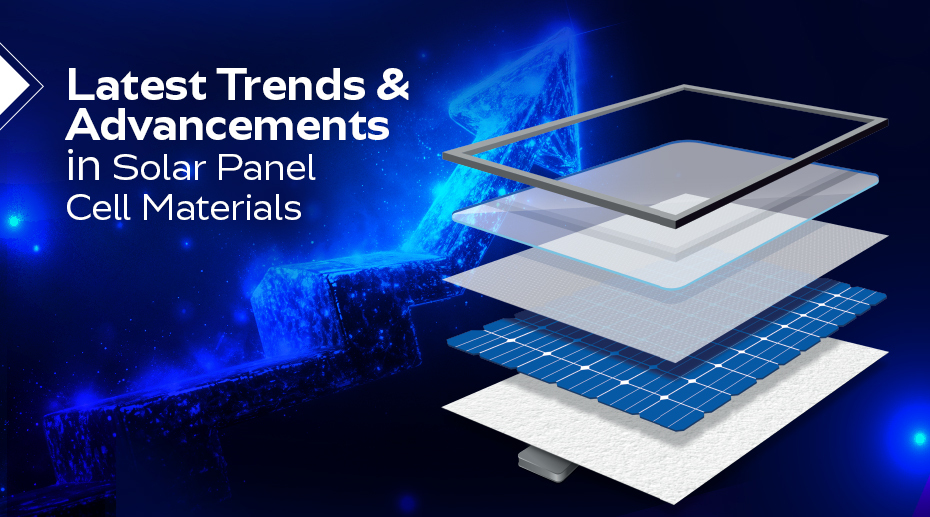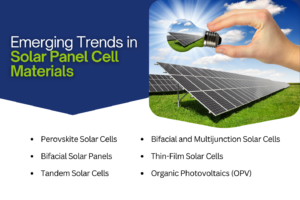Latest Trends in Solar Panel Cell Materials

Why Advancements in Solar Panel Materials Matter?
Solar energy is becoming an integral part of our lives, visiting homes, businesses, and even cities. Solar panels must be made cheaper, but also powerful enough to meet soaring energy demands and fight climate change. That’s where the latest trend in solar materials comes in.
New materials coming in, like perovskites, push solar panel efficiencies much higher than ever before. If made with these new materials, solar panels with a price drop could allow thousands of people access to clean energy. By improving on solar panel materials, we are one step closer to making energy greener and more accessible to everyone.
The Journey of Solar Cell Materials: From Silicon to Advanced Composites
Observing the development of solar cell materials has been like seeing a technological baby being born. Although silicon screens were a positive start, many people are now dubious about the idea of using novel materials. Think about polymer solar cells. By 2023, they had improved their efficiency by 19.3%. It was already above 10% in 2015! Bendable panels and polymers are the latest trend in solar materials, breaking new ground and offering up intriguing new possibilities. The market for next-generation solar cells is expected to increase rapidly, from $2.53 billion in 2023 to $2.95 billion in 2024, at a pace of 16.6% per year.
Current State of Solar Panel Materials
Common Materials used Today
These days, materials utilized count a lot for the amount of energy captured by these solar panels emanating from the sun. Now let’s take a glance at a few of the most popular raw materials used for creating solar panels and how they contribute to powering the world:.
Silicon
First is Silicon. Silicon has been produced and used for decades. Moreover, it is still probably one of the most preferred products in solar panels. It is rather very efficient, durable, and so forth.
Thin-Film Solar Panels
With technology, in the not-so-distant past, thin-film solar panels have come of age because their material may be a cadmium telluride or amorphous silicon, which is essentially a non-crystalline form. They are lighter but flexible.
Copper Indium Gallium Selenide, or CIGS
This one seems to be a little mouthful. Still, let the term frighten you not. Another kind of thin-film material is CIGS, which has a step increase in efficiency.
Limitations of Existing Materials
While solar panels have improved much, they do not come without their issues.
Efficiency
Efficiency is basically how much sunlight a solar panel can convert into usable energy. Now, if you think of a solar panel like a sponge soaking up sunlight, the more it soaks up, the better, right? Well, traditional solar panels made of silicon can only convert about 15-22% of the sunlight they capture into energy. That means, for every 100 units of sunlight, only a small chunk gets turned into usable power.
Cost
Here’s where things get tricky. Solar panels can be a bit expensive upfront. Silicon panels are reliable, but they cost more to make. That’s why the initial installation can sometimes make people hesitate. And while the cost has come down over time, it still feels like you’re paying a premium. Thin-film panels are cheaper, but remember, they’re less efficient, so you’d need more panels to generate the same amount of power.
Durability
Solar panels are designed to last but have limitations. For example, thin-film panels are very light and thus degrade much faster than the heavier-duty silicon-based panels. Although silicon panels last up to 25-30 years, they aren’t invincible. Harsh weather, such as hailstorms or strong winds, will cause them to suffer the same kind of damage as your car in a bad storm.
Size and Space Requirements
Here is one that many people do not think about at first. Although silicon solar panels are more efficient than thin-film panels, they do take up a lot of space to generate enough power. Try to imagine powering your whole house with a bunch of large, bulky panels on your roof. If you have a small roof or live in a dense city, you might struggle to fit all the panels you need.
Energy Storage
Now this one isn’t directly about the panels themselves but is still a big part of the equation. Solar panels, no matter how efficient, can only work when the sun is shining. What happens at night or on cloudy days? We require batteries or energy storage systems to store the energy gathered during the day. Guess what? Energy storage solutions are still expensive, and the technology is not advanced enough for our expectations.
Manufacturing and Material Limitations
The process of making solar panels is not as easy as it sounds. Silicon, for example, requires a lot of energy to produce, and that process isn’t always the most eco-friendly. While it’s still much better than burning fossil fuels, we’re always looking for ways to make production cleaner and cheaper. Thin-film panels are a bit better in this area, but they still have their own challenges. The materials used for the solar panels are not always easy to source in a sustainable manner, so that affects the overall environmental impact of solar energy.
Temperature Sensitivity
Solar panels, especially the silicon variety, don’t like extreme temperatures. While they can handle heat pretty well, their efficiency tends to drop when they get too hot. Imagine running a race in the scorching sun – you’d slow down too, right? Solar panels behave the same way. High temperatures can reduce their energy output. This means that in places with extremely hot weather, solar panels might not perform at their best.
Aesthetic and Integration Problems
Let’s admit; solar panels sometimes take quite a bulky and unplaced image on the rooftop. Thin-film panel appears a bit flexible, integrates the building material such as the windows or rooftops yet seems not to have that sharp or sleek look everyone is targeting in the market. All would like to see designs from clean and modern styles without incorporating solar panels.
Emerging Trends in Solar Panel Cell Materials

Let’s talk about some of the latest trends in solar materials that are really turning heads in the solar industry. These innovations are giving solar energy a major boost and bringing us closer to a cleaner, greener future.
1. Perovskite Solar Cells
Perovskites are a group of materials that are quickly gaining attention for their amazing potential in solar panels. They’ve gone from just 3% efficiency in 2009 to a whopping 25% today! What’s the catch? Well, they’re cheaper to make and easier to produce than traditional silicon solar cells. Imagine a solar panel that’s not just better but also quicker and cheaper to manufacture – that’s what perovskites are offering.
2. Bifacial Solar Panels
Bifacial solar panels are like the multitaskers of the solar world. These panels can collect sunlight from both the front and the back. That means they can capture sunlight reflected off surfaces like the ground or rooftops, boosting their overall efficiency. So, it’s a bit like getting more bang for your buck – you’re harnessing more energy from the same space!
3. Tandem Solar Cells
Tandem solar cells are like a team of superheroes working together. They combine two different types of solar cells to capture more sunlight and convert it into energy. One layer absorbs the sunlight, while the other absorbs different wavelengths, making the whole system way more efficient than regular single-layer cells. Think of it as using both hands to catch a ball instead of just one – you’ll catch more that way!
4. Bifacial and Multijunction Solar Cells
These cells take things a step further. By combining multiple layers of materials that each absorb different parts of sunlight, multijunction cells boost efficiency dramatically. Bifacial panels help by collecting light from both sides. The two together can squeeze every drop of energy from sunlight, like squeezing a sponge to get every last drop of water.
5. Thin-Film Solar Cells
Thin-film solar cells are lightweight and flexible, making them perfect for applications where traditional panels might be too bulky. They’re made from layers of semiconductor materials that are just a fraction of the thickness of silicon solar panels. They’re cheaper to produce and can be used on surfaces like windows or roofs where traditional panels wouldn’t fit.
6. Organic Photovoltaics (OPV)
OPVs use organic materials (basically carbon-based) to generate solar power. These panels are lightweight and flexible, just like thin-film solar cells, but with the added benefit of being more eco-friendly in production. Although they’re still behind in efficiency compared to silicon, their low-cost production and flexibility make them a great candidate for the future, especially in wearables or portable devices.
Other Advancements in Solar Industries
It’s evolving extremely fast, with some astounding breakthroughs really changing the game. It is bringing forth nanotechnology and sustainable innovations, quite a number of things being done from behind the curtain for this solar power to be that much even better.
Nanotechnology in Solar Cells
Using nanomaterials in solar cells helps us improve light absorption, hence increasing the cells’ efficiency. Quantum dots are tiny particles that are known to capture light in a much better way and therefore make next-gen solar cells much better at converting sunlight into energy.
Sustainability and Eco-Friendly Innovations
The entire philosophy of pushing for better solar energy is based on the core of sustainability. It involves the latest trend, wherein new solar materials are used for recyclable solar panel production. This implies that as their useful life ends, such panels can be broken and used again to reduce wasteful byproducts. But besides that, what’s amazing is the area of organic and bio-inspired solar cells – made from purely natural components less harmful to the environment.
Improving on Methods of Manufacturing Techniques
But it’s not only material improvement, which also touches on how this is going to be achieved. One cool idea is the development of flexible and lightweight solar cells, which are perfect for portability. You might even see solar panels where conventional ones couldn’t—on backpacks or clothing! Then printable solar panels—whose panels are produced roll-to– roll—have become really popular. Like publishing a newspaper but using solar energy, this speeds up and lowers the manufacturing cost process! These developments are making solar energy not only more reasonably priced but also simpler to include into our everyday life.
Conclusion
The new trends in solar materials have opened exciting new avenues for collecting and utilizing energy. Notable and recognized advances include perovskite solar cells, bifacial panels, and organic photovoltaics, allowing greater energy efficiency, lower costs, and greater environmental sustainability for solar power.
The future of these innovations depends on research and investment that allow us to tap into new streams of renewable energy that may finally turn the tides. By warmly welcoming the encroaching solar transition into portions of our lives, either as investments or in support of greener options, any one of us can make a difference in creating an enthralled clean world thanks to solar energy.
